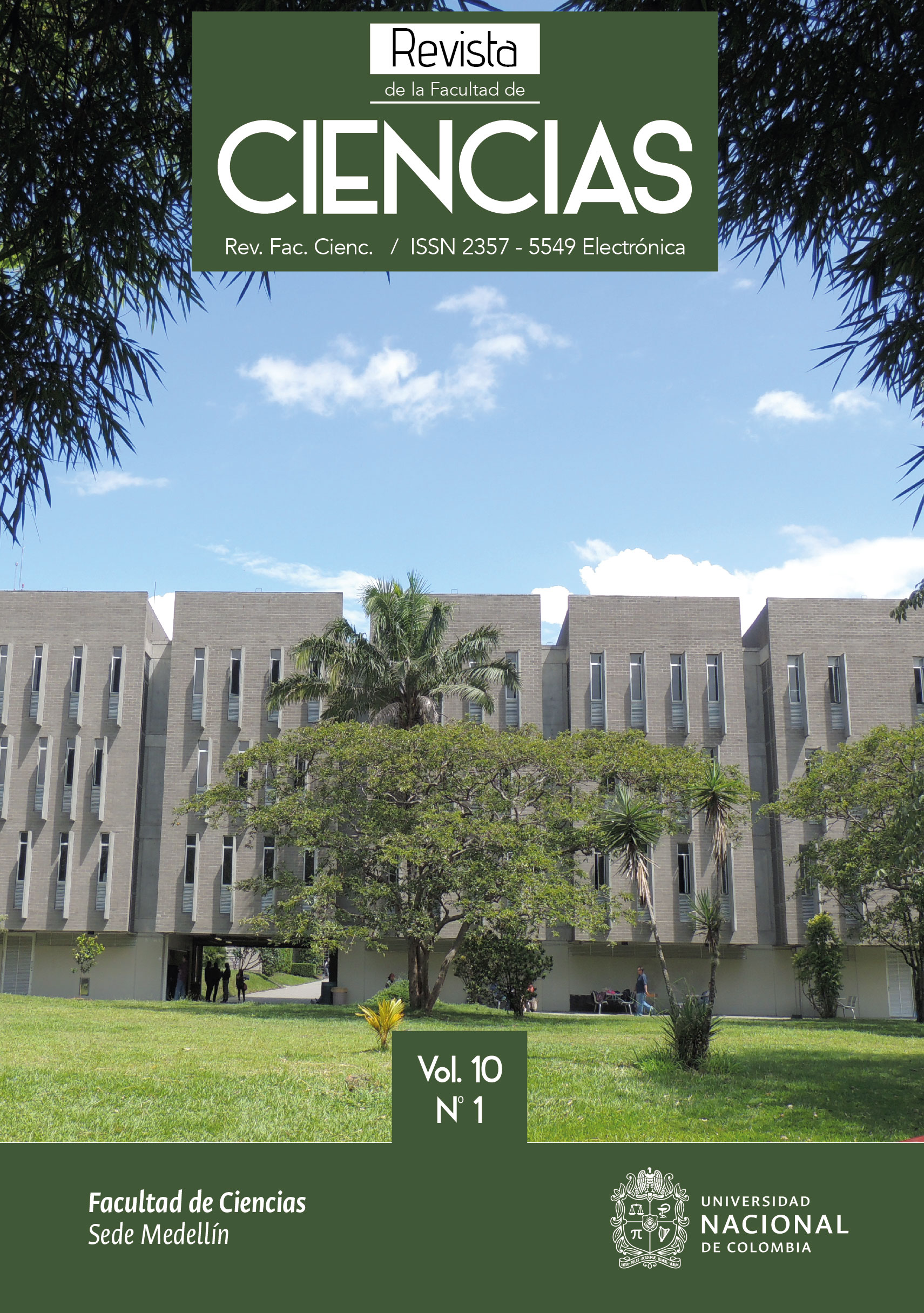A proposal for estimating intensity functions in a three-state model in the presence of arbitrary censoring
Una propuesta para estimar funciones de intensidad en un modelo de tres estados en presencia de censura arbitraria
DOI:
https://doi.org/10.15446/revfaccienc.v10n1.84237Palabras clave:
Statistics, Intensity function, Markov model, Censored data (en)Estadística, función de intensidad, modelo de Markov, datos censurados (es)
Descargas
Referencias
Abramowitz, M. & Stegun, I. A. (1972). Handbook of Mathematical Functions with Formulas, Graphs, and Mathematical Tables. New York: Dover Publications, Inc.
Andersen, P. K., Borgan, O., Gill, R. D. & Keiding, N. (1993). Statistical models based on counting processes. Springer - Verlag. New York. DOI: https://doi.org/10.1007/978-1-4612-4348-9
Bhat, U. N. (1984). Elements of applied stochastic processes. 2nd ed. New York: John Wiley and sons.
Cox, D. R. (1972). Regression models and life tables (with discussion). Journal of the Royal Statistical Society 32(Series B), 187-220. DOI: https://doi.org/10.1111/j.2517-6161.1972.tb00899.x
Faddy, M. J. (1976). A note on the general time-dependent stochastic compartmental model. Biometrics 32, 443-448. DOI: https://doi.org/10.2307/2529513
Frydman, H. (1992). A Nonparametric estimation procedure for a periodically observed three state Markov process, with application to AIDS. Journal of Royal Statistical Society 4(Series B), 853-866. DOI: https://doi.org/10.1111/j.2517-6161.1992.tb01457.x
Hajihosseini, M., Kazemi, T. & Faradmal, J. (2016). Multistate models for survival analysis of cardiovascular disease process. Revista Española de Cardiología 69(7), 714-715. DOI: https://doi.org/10.1016/j.rec.2016.04.009
Harezlak, J., Gao, S. & Hui, S. L. (2003). An illness-death stochastic model in the analysis of longitudinal dementia data. Statistics in Medicine 22, 1465-1475. DOI: https://doi.org/10.1002/sim.1506
Hedeker, H., Siddiqui, O. & Hu, F. B. (2000). Random-effects regression analysis of correlated group-time survival data. Statistical Methods in Medical Research 9, 161-179. DOI: https://doi.org/10.1191/096228000667253473
Joly, P. and Commenges, D. (1999). A penalized likelihood approach for a progressive three-state model with censored and truncated data: Application to AIDS. Biometrics 55, 887-890. DOI: https://doi.org/10.1111/j.0006-341X.1999.00887.x
Joly, P., Commenges, D. & Letenneur, L. (1998). A penalized likelihood approach for arbitrarily censored and truncated data: Application to age-specic incidence of dementia. Biometrics 55(1), 185-194. DOI: https://doi.org/10.2307/2534006
Kay, R. (1986). A Markov model for analyzing cancer markers and disease states in survival studies. Biometrics 42, 855-865. DOI: https://doi.org/10.2307/2530699
Kryscio, R. J., Schmit, F. A., Salazar, J., Mendiondo, M. S. & Markesbery, W. R. (2016). Risk factors for transitions from normal to mild cognitive impairment and dementia. Neurology 66, 828-832. DOI: https://doi.org/10.1212/01.wnl.0000203264.71880.45
Van der Vaart, A.W. (2000). Asymptotic statistics. Cambridge Series in Statistical and Probabilistic Mathematics. Cambridge University Press, Cambridge.
Lee, E. T. (1992). Statistical methods for survival data analysis. 2nd Ed. John Wiley & Sons. New York.
Salazar, J. C., Palomino, R., Calvo, E., Rojas, A., Hincapié, M. E., Anaya, J. M. & Díaz, F. (2007). Three state Markov model: Comparing three parameterizations of the transition intensity rate.
Application to rheumatoid arthritis data. Revista Colombiana de Estadística, 30(2), 213-229.
Salazar, J. C., Schmitt, F. A., Yu, L., Mendiondo, M. S. & Kryscio, R. J. (2005). Shared random effects analysis of multi-state Markov models: application to a longitudinal study of transitions to dementia. Statistics in Medicine 26(3), 568-580. DOI: https://doi.org/10.1002/sim.2437
Salgado, K., Salazar-Uribe, J. C., Gallo-Villegas, J., Valencia, A., Española-Fernández, D., Mesa, C., de la Calle, J., Montoya, Y.& Aristizábal, D. (2018). Evaluación de la costo-efectividad de un modelo integral de tratamiento ambulatorio en pacientes con síndrome coronario agudo: aplicación de un modelo de Markov probabilístico. Pan American Journal of Public Health 42, 1-9. DOI: https://doi.org/10.26633/RPSP.2018.10
SAS Institute Inc. Base SAS R 9.2 (2011). Procedures Guide. Cary, NC: SAS Institute Inc.
Tovar, R. & Salazar, J. C. (2009). A linear mixed model adapted to a markov chain with ordinal state space. Application to data about grade point average (GPA). Revista Colombiana de Estadística 32(2), 213-230.
Wei, S., Xu, L. & Kryscio, R. (2014). Markov transition model to dementia with death as a competing event. Computational Statistics and Data Analysis 80, 78-88. DOI: https://doi.org/10.1016/j.csda.2014.06.014
Yeh H., Chan, W., Symanski, E. & Davis, B. (2010). Estimating transition probabilities for ignorable intermittent missing data in a discrete-time markov chain Communications in Statistics: Simulation and Computation 39(2), 433-448. DOI: https://doi.org/10.1080/03610910903480800
Cómo citar
APA
ACM
ACS
ABNT
Chicago
Harvard
IEEE
MLA
Turabian
Vancouver
Descargar cita
Licencia
Derechos de autor 2021 Revista de la Facultad de Ciencias

Esta obra está bajo una licencia internacional Creative Commons Atribución-NoComercial-SinDerivadas 4.0.
Los autores o titulares del derecho de autor de cada artículo confieren a la Revista de la Facultad de Ciencias de la Universidad Nacional de Colombia una autorización no exclusiva, limitada y gratuita sobre el artículo que una vez evaluado y aprobado se envía para su posterior publicación ajustándose a las siguientes características:
1. Se remite la versión corregida de acuerdo con las sugerencias de los evaluadores y se aclara que el artículo mencionado se trata de un documento inédito sobre el que se tienen los derechos que se autorizan y se asume total responsabilidad por el contenido de su obra ante la Revista de la Facultad de Ciencias, la Universidad Nacional de Colombia y ante terceros.
2. La autorización conferida a la revista estará vigente a partir de la fecha en que se incluye en el volumen y número respectivo de la Revista de la Facultad de Ciencias en el Sistema Open Journal Systems y en la página principal de la revista (https://revistas.unal.edu.co/index.php/rfc/index), así como en las diferentes bases e índices de datos en que se encuentra indexada la publicación.
3. Los autores autorizan a la Revista de la Facultad de Ciencias de la Universidad Nacional de Colombia para publicar el documento en el formato en que sea requerido (impreso, digital, electrónico o cualquier otro conocido o por conocer) y autorizan a la Revista de la Facultad de Ciencias para incluir la obra en los índices y buscadores que estimen necesarios para promover su difusión.
4. Los autores aceptan que la autorización se hace a título gratuito, por lo tanto renuncian a recibir emolumento alguno por la publicación, distribución, comunicación pública y cualquier otro uso que se haga en los términos de la presente autorización.
5. Todos los contenidos de la Revista de la Facultad de Ciencias, están publicados bajo la Licencia Creative Commons Atribución – No comercial – Sin Derivar 4.0.
MODELO DE CARTA DE PRESENTACIÓN y CESIÓN DE DERECHOS DE AUTOR





















